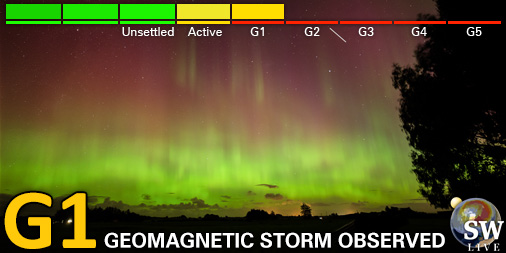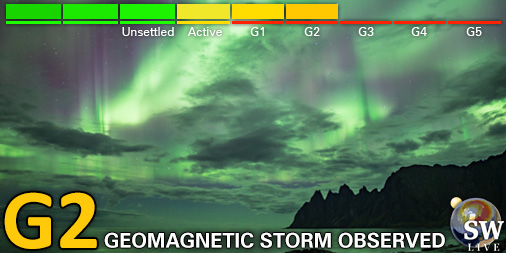Viewing archive of Friday, 3 January 2003
Solar activity report
Any mentioned solar flare in this report has a scaling factor applied by the Space Weather Prediction Center (SWPC). Because of the SWPC scaling factor, solar flares are reported as 42% smaller than for the science quality data. The scaling factor has been removed from our archived solar flare data to reflect the true physical units.
Report of Solar-Geophysical Activity 2003 Jan 03 2200 UTCPrepared by the NOAA © SWPC and processed by SpaceWeatherLive.com
Joint USAF/NOAA Report of Solar and Geophysical Activity
SDF Number 003 Issued at 2200Z on 03 Jan 2003IA. Analysis of Solar Active Regions and Activity from 02-2100Z to 03-2100Z
Solar activity was at low levels. Several low level
C-class flares occurred today. The largest optically correlated
event was a C2.0/Sf flare that occurred at 03/1445 UTC from Region
234 (N19W60) as region underwent steady decay today. Region 242
(S08E48) produced several B and C-class flares while showing areal
growth of spot complex through the period. An eruptive prominence
on the west limb (N22W90) occurred at 03/1506 UTC producing a CME
seen on NASA/LASCO imagery that does not appear to be earth
directed. Regions 243 (S19W34), 244 (S15E58), and 245 (N12E74) were
newly assigned today.
IB. Solar Activity Forecast
Solar activity is expected to be at
low levels. A very slight chance of an isolated low level M-class
flare is possible from Region 242.
IIA. Geophysical Activity Summary 02-2100Z to 03-2100Z
The geomagnetic field was predominantly quiet to unsettled. Isolated
active to minor storm conditions were observed between 03/1500 to
1800 UTC due to the effects of a favorably positioned coronal hole.
The greater than 2 MeV electron flux at geosynchronous orbit reached
high levels during the past 24 hours.
IIB. Geophysical Activity Forecast
The geomagnetic field is
expected to be at predominantly unsettled to active levels on day
one of the forecast period due to high speed stream coronal hole.
Days two and three should see a return to quiet to unsettled
conditions as the geo-effective coronal hole wanes.
III. Event Probabilities 04 Jan to 06 Jan
| Class M | 20% | 20% | 20% |
| Class X | 01% | 01% | 01% |
| Proton | 01% | 01% | 01% |
| PCAF | green | ||
IV. Penticton 10.7 cm Flux
Observed 03 Jan 138 Predicted 04 Jan-06 Jan 135/140/145 90 Day Mean 03 Jan 164
V. Geomagnetic A Indices
Observed Afr/Ap 02 Jan 005/008 Estimated Afr/Ap 03 Jan 010/015 Predicted Afr/Ap 04 Jan-06 Jan 012/015-010/015-005/010
VI. Geomagnetic Activity Probabilities 04 Jan to 06 Jan
| A. Middle Latitudes | |||
|---|---|---|---|
| Active | 25% | 25% | 15% |
| Minor storm | 10% | 05% | 01% |
| Major-severe storm | 01% | 01% | 01% |
| B. High Latitudes | |||
|---|---|---|---|
| Active | 30% | 30% | 25% |
| Minor storm | 10% | 10% | 05% |
| Major-severe storm | 01% | 01% | 01% |
All times in UTC
Current data suggests there is a slight possibility for aurora to appear at the following high latitude regions in the near future
Whitehorse, YTAnchorage, AK, Fairbanks, AK, Juneau, AK, Utqiagvik, AK
Latest news
Latest forum messages
Unspecified geomagnetic activity 2221Incoming & Unnumbered Active Regions 1660AR4048 114New satellites - Proba-3, PUNCH, SWFO-L1, GOES-U/19 36Filaments and prominences 750
More topicsSupport SpaceWeatherLive.com!
A lot of people come to SpaceWeatherLive to follow the Sun's activity or if there is aurora to be seen, but with more traffic comes higher server costs. Consider a donation if you enjoy SpaceWeatherLive so we can keep the website online!

Latest alerts
10:00 UTC - Hemispheric Power Index
The OVATION model predicts the Hemispheric Power Index to reach 78GW at 10:32 UTC
04:15 UTC - Geomagnetic activity
Minor G1 geomagnetic storm (Kp5) Threshold Reached: 04:05 UTC
03:15 UTC - Geomagnetic activity
Moderate G2 geomagnetic storm (Kp6) Threshold Reached: 02:59 UTC
01:00 UTC - Geomagnetic activity
Minor G1 geomagnetic storm (Kp5) Threshold Reached: 00:51 UTC
Friday, 4 April 2025
23:30 UTC - Geomagnetic activity
Minor G1 geomagnetic storm (Kp5) Threshold Reached: 23:17 UTC
Space weather facts
| Last X-flare | 2025/03/28 | X1.1 |
| Last M-flare | 2025/04/01 | M2.5 |
| Last geomagnetic storm | 2025/04/04 | Kp5+ (G1) |
| Spotless days | |
|---|---|
| Last spotless day | 2022/06/08 |
| Monthly mean Sunspot Number | |
|---|---|
| March 2025 | 134.2 -20.4 |
| April 2025 | 148 +13.8 |
| Last 30 days | 130.9 -15.2 |






